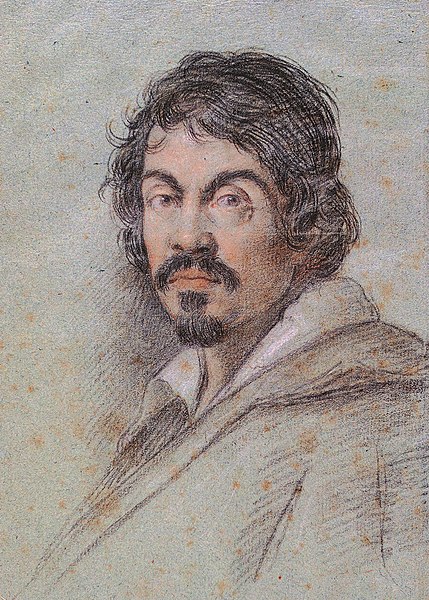
Born: 29 September 1571, Milan
Died: 18 July 1610 (aged 38)
Period: Baroque
The Life of Caravaggio
Michelangelo Merisi da Caravaggio (1571–1610) was a revolutionary figure in European art, whose innovative approach to painting had a profound impact on the Baroque style. Born in Milan, Italy, he moved to Rome in his early twenties, where he began his career in painting. Caravaggio is celebrated for his dramatic use of light and shadow, a technique known as chiaroscuro, which added a sense of depth and realism to his works. He was also known for using ordinary people from the streets as models for his religious and mythological scenes, bringing a new level of emotional intensity and human realism to these subjects.
Caravaggio’s early works in Rome, such as “The Calling of Saint Matthew” and “The Martyrdom of Saint Matthew,” garnered him significant attention and commissions from wealthy patrons. However, his life was marked by tumult and controversy. Known for his fiery temperament, Caravaggio frequently found himself in trouble with the law. In 1606, this volatility led to a fatal duel, forcing him to flee Rome with a death sentence over his head.
Caravaggio spent the last four years of his life on the run, moving between Naples, Malta, and Sicily. During this time, he continued to produce masterpieces like “The Beheading of Saint John the Baptist” and “The Burial of Saint Lucy.” Despite his circumstances, his work remained in high demand, and he continued to receive commissions from important patrons.
Caravaggio’s influence on the art world was immense. He is considered a pioneer of the Baroque style, which emphasized dramatic, emotional content and used light and shadow to achieve a sense of three-dimensionality on the canvas. His techniques and approach to subject matter had a lasting impact on subsequent generations of artists, including Rubens, Rembrandt, and Vermeer.
Tragically, Caravaggio’s life was cut short at the age of 38. While on his way to Rome in hopes of receiving a pardon, he died under mysterious circumstances. Some accounts suggest he succumbed to fever, while others hint at foul play. Despite his untimely death, Caravaggio’s legacy endured, and he is remembered as one of the most influential and groundbreaking artists in the history of Western art.
Caravaggio‘s Notable Works
Caravaggio is renowned for his dramatic use of light and shadow and his realistic approach to human figures and emotions. Among his extensive oeuvre, some works stand out for their influence, technical mastery, and the stories they tell. Here are ten of the most famous works by Caravaggio, each showcasing his unique style and contribution to the world of art:
- The Calling of Saint Matthew (1599-1600) – This painting illustrates the moment Jesus Christ inspires Matthew to follow him, capturing the transformative moment with dramatic lighting and expressive figures. It’s located in the Contarelli Chapel, San Luigi dei Francesi, Rome.
- Judith Beheading Holofernes (c. 1599) – A vivid and graphic depiction of the biblical story of Judith, this painting is celebrated for its dramatic intensity and Caravaggio’s mastery of chiaroscuro. It’s housed in the Galleria Nazionale d’Arte Antica, Rome.
- Basket of Fruit (c. 1599) – A still life that stands out for its detailed realism and the way it showcases Caravaggio’s skill in depicting textures and surfaces. It’s currently in the Biblioteca Ambrosiana, Milan.
- The Supper at Emmaus (1601) – This work captures the moment when the resurrected Jesus is recognized by his disciples in Emmaus. It’s known for its emotional depth and is located in the National Gallery, London.
- The Conversion of Saint Paul (1601) – Another masterpiece that illustrates a biblical conversion moment, showcasing Caravaggio’s expertise in using light to highlight the emotional climax of the scene. It’s found in the Cerasi Chapel, Santa Maria del Popolo, Rome.
- The Martyrdom of Saint Matthew (1599-1600) – This painting depicts the death of Saint Matthew, filled with dramatic action and intense emotion, located in the Contarelli Chapel, San Luigi dei Francesi, Rome.
- David with the Head of Goliath (c. 1610) – A powerful and personal work, believed to reflect Caravaggio’s own turmoil and remorse. The head of Goliath is often considered a self-portrait of the artist. It’s housed in the Galleria Borghese, Rome.
- Amor Vincit Omnia (Love Conquers All) (1601-1602) – Featuring a provocative image of Cupid standing victorious over earthly goods and knowledge, symbolizing the power of love, located in the Gemäldegalerie, Berlin.
- The Entombment of Christ (1603-1604) – Considered one of his masterpieces, this painting depicts the burial of Christ with stark realism and emotional depth. It’s located in the Vatican Museums, Vatican City.
- The Beheading of Saint John the Baptist (1608) – Known for being the only work signed by Caravaggio (in the blood from John’s neck), this painting is remarkable for its dramatic use of light and space. It’s found in St. John’s Co-Cathedral, Valletta, Malta.
Each of these works exemplifies Caravaggio’s innovative approach to painting, his mastery of light and shadow, and his profound influence on the development of Western art.